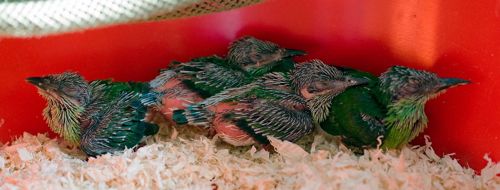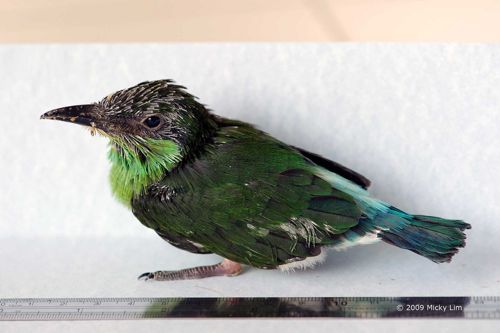Check out the earlier parts of the Blue-throated Bee-eaters (Merops viridis) saga: 1, 2, 3, 4, 5, 6, 7, 8, 9 and 10.
Micky Lim a.k.a. limmick has been “baby sitting” these four chicks since their rescue. And it has been a stressful time as they demand to be fed constantly. The cage also needs cleaning and its occupants their regular dry-cleaning.
Although the chicks ate heartily and growing well as seen in the increase in size and feather development, there was always the worry of imprinting. Can the chicks survive when released into the wild? Would they be able to forage in the absence of handouts of mealworms? Will they be able to recognise predators and avoid them? Normally, the adults would be around to teach the chicks once they fledge and leave the safety of the nest. The adults would still feed them but slowly get them to forage on their own. In this case they would be on their own. A bleak future indeed.
As seen in the above image, their state of growth varies. The oldest (below) has its wing and tail feathers nearly fully developed, although its throat and head feathers have yet to be fully unsheathed. However, the younger chicks are covered with pine feathers that have yet to begin unsheathing. They have much growing up to do.
Long term documentation of birds can result in emotional attachment to the extent that the photographers feel for their safety. Thus the decision to rescue the chicks when their nests were in danger of being obliterated. This was not interfering with nature. Rather, it was interfering with human activities that interfered with nature. Unfortunately, due to the rapidity of developmental activities, there was no choice but to dig the nests up, although a reprieve of a week or so may just see more chicks fledging naturally. There will definitely be controversies well after the dust have settled. But one significant factor emerged – the unanimous decision of the photographers who were then documenting the nesting to go ahead with the rescue.
For decades citizen scientists have been involved in documenting birds in Singapore (also, see “Watching Birdwatchers Watching Birds”). Since the early 2000s, bird photographers have been at the forefront of bird sightings and the study of bird behaviour. And this is the first occasion where citizen scientists got involved in a mass rescue of chicks in Singapore. Previously, a few concerned citizens may pick up a displaced chick in the misguided notion that hand-rearing it would contribute in its survival. This may not be so – see HERE. But mass rescue in the face of human activities? This is a first! And it speaks well for bird photographers.
Images by Micky Lim.
This post is a cooperative effort between NaturePixels.org and BESG to bring the study of bird behaviour through photography to a wider audience.











2 Responses
Interesting story on rescue. Is there any update on the chicks? Did they survive?
The earlier rescues involved older chicks about ready to fledge. The chicks were kept for a short while and released. The last rescue involved young chicks and they probably did not survive.